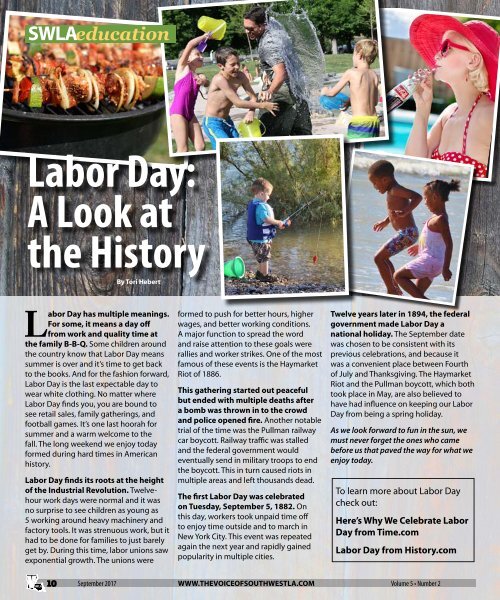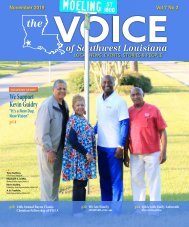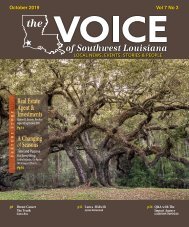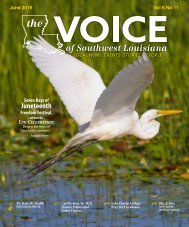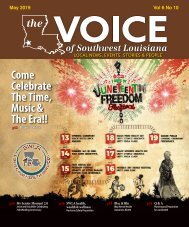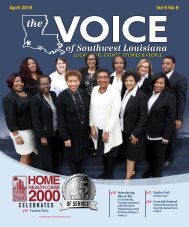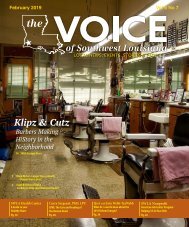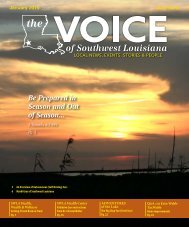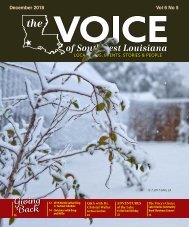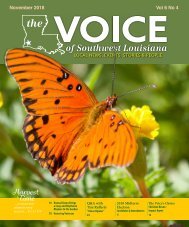The Voice of Southwest Louisiana September 2017 Issue
The Voice of Southwest Louisiana News Magazine September 2017
The Voice of Southwest Louisiana News Magazine September 2017
You also want an ePaper? Increase the reach of your titles
YUMPU automatically turns print PDFs into web optimized ePapers that Google loves.
SWLA education<br />
Labor Day:<br />
A Look at<br />
the History<br />
By Tori Hebert<br />
Labor Day has multiple meanings.<br />
For some, it means a day <strong>of</strong>f<br />
from work and quality time at<br />
the family B-B-Q. Some children around<br />
the country know that Labor Day means<br />
summer is over and it’s time to get back<br />
to the books. And for the fashion forward,<br />
Labor Day is the last expectable day to<br />
wear white clothing. No matter where<br />
Labor Day finds you, you are bound to<br />
see retail sales, family gatherings, and<br />
football games. It’s one last hoorah for<br />
summer and a warm welcome to the<br />
fall. <strong>The</strong> long weekend we enjoy today<br />
formed during hard times in American<br />
history.<br />
Labor Day finds its roots at the height<br />
<strong>of</strong> the Industrial Revolution. Twelvehour<br />
work days were normal and it was<br />
no surprise to see children as young as<br />
5 working around heavy machinery and<br />
factory tools. It was strenuous work, but it<br />
had to be done for families to just barely<br />
get by. During this time, labor unions saw<br />
exponential growth. <strong>The</strong> unions were<br />
formed to push for better hours, higher<br />
wages, and better working conditions.<br />
A major function to spread the word<br />
and raise attention to these goals were<br />
rallies and worker strikes. One <strong>of</strong> the most<br />
famous <strong>of</strong> these events is the Haymarket<br />
Riot <strong>of</strong> 1886.<br />
This gathering started out peaceful<br />
but ended with multiple deaths after<br />
a bomb was thrown in to the crowd<br />
and police opened fire. Another notable<br />
trial <strong>of</strong> the time was the Pullman railway<br />
car boycott. Railway traffic was stalled<br />
and the federal government would<br />
eventually send in military troops to end<br />
the boycott. This in turn caused riots in<br />
multiple areas and left thousands dead.<br />
<strong>The</strong> first Labor Day was celebrated<br />
on Tuesday, <strong>September</strong> 5, 1882. On<br />
this day, workers took unpaid time <strong>of</strong>f<br />
to enjoy time outside and to march in<br />
New York City. This event was repeated<br />
again the next year and rapidly gained<br />
popularity in multiple cities.<br />
Twelve years later in 1894, the federal<br />
government made Labor Day a<br />
national holiday. <strong>The</strong> <strong>September</strong> date<br />
was chosen to be consistent with its<br />
previous celebrations, and because it<br />
was a convenient place between Fourth<br />
<strong>of</strong> July and Thanksgiving. <strong>The</strong> Haymarket<br />
Riot and the Pullman boycott, which both<br />
took place in May, are also believed to<br />
have had influence on keeping our Labor<br />
Day from being a spring holiday.<br />
As we look forward to fun in the sun, we<br />
must never forget the ones who came<br />
before us that paved the way for what we<br />
enjoy today.<br />
To learn more about Labor Day<br />
check out:<br />
Here’s Why We Celebrate Labor<br />
Day from Time.com<br />
Labor Day from History.com<br />
10<br />
<strong>September</strong> <strong>2017</strong> WWW.THEVOICEOFSOUTHWESTLA.COM Volume 5 • Number 2


